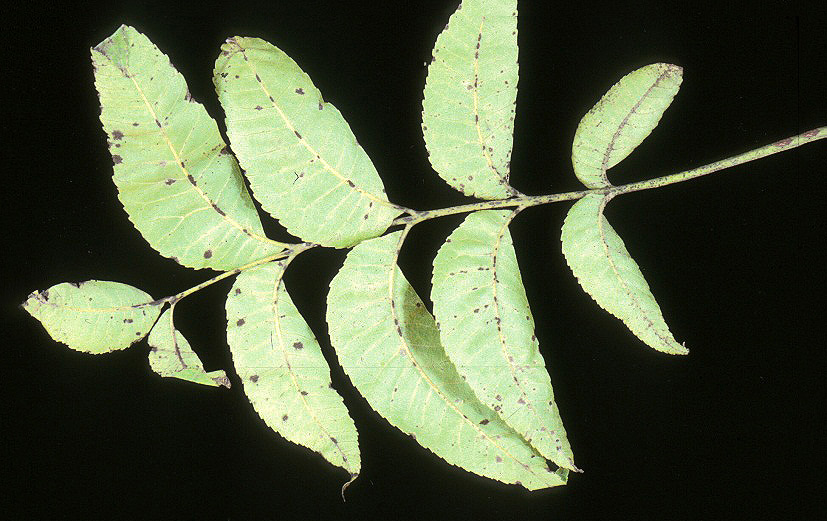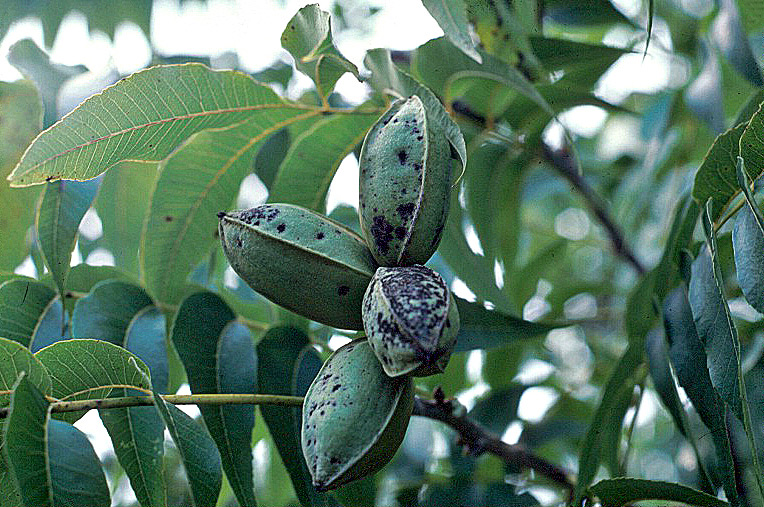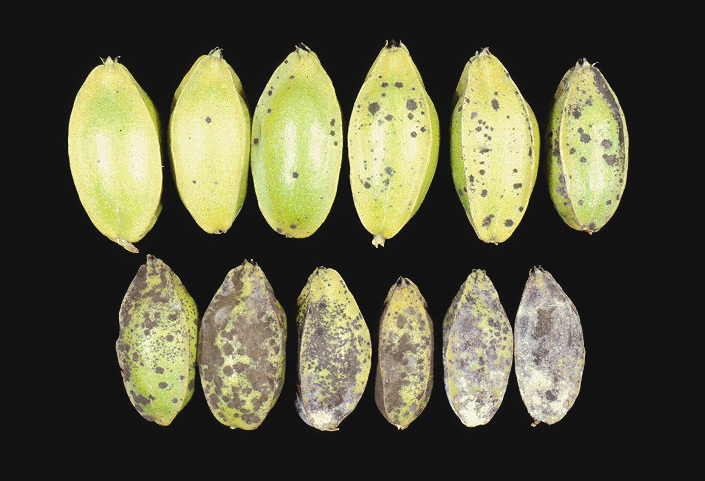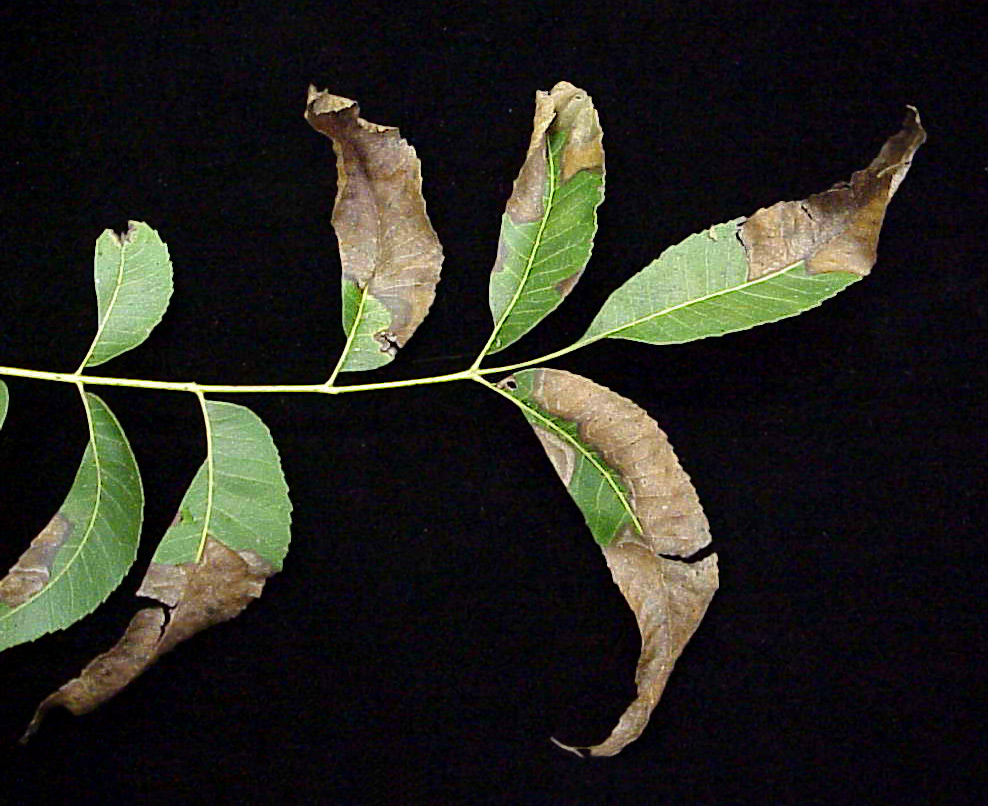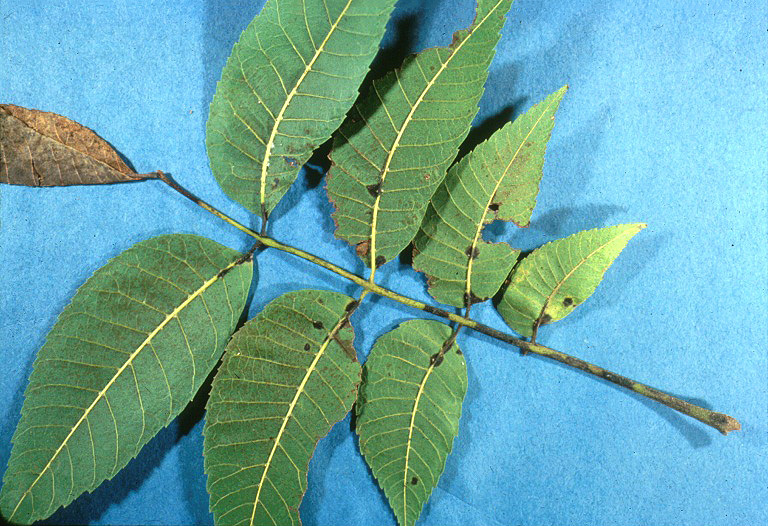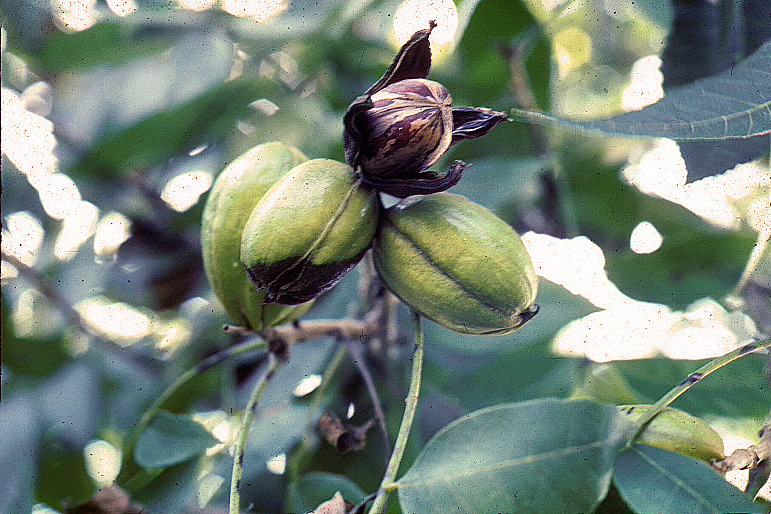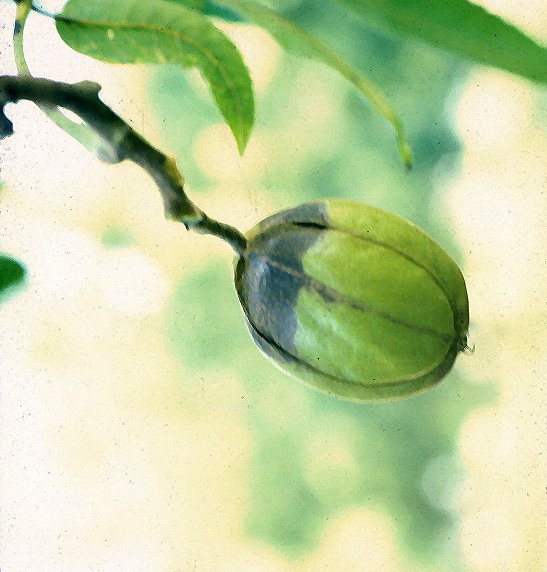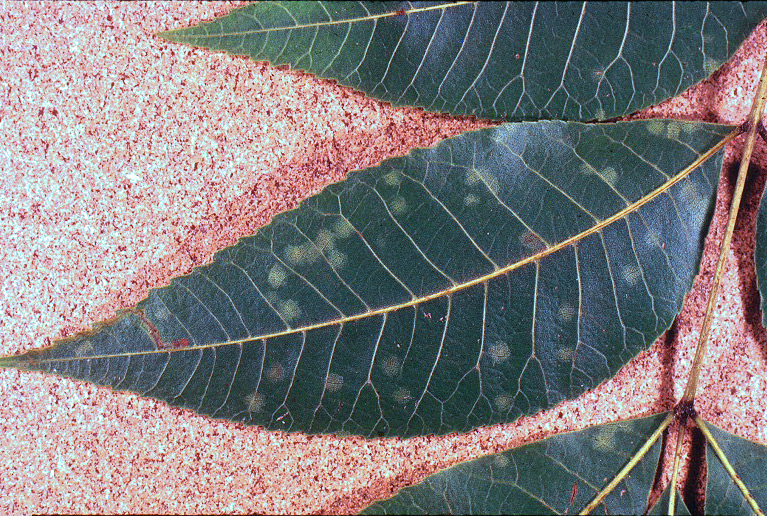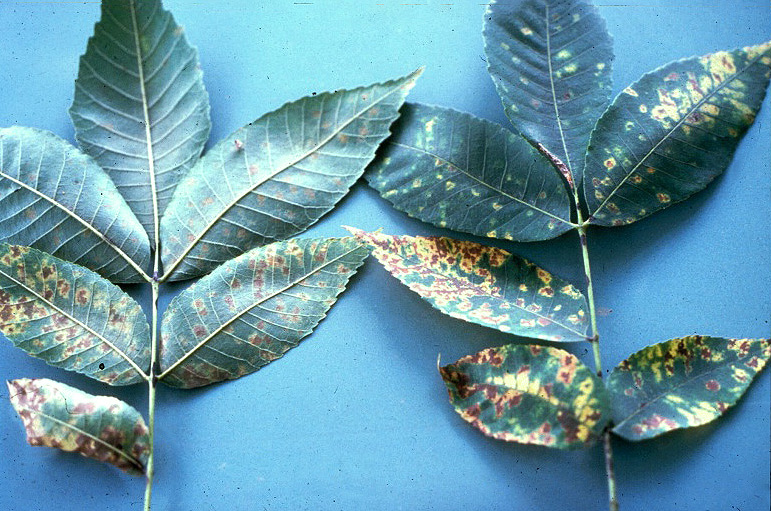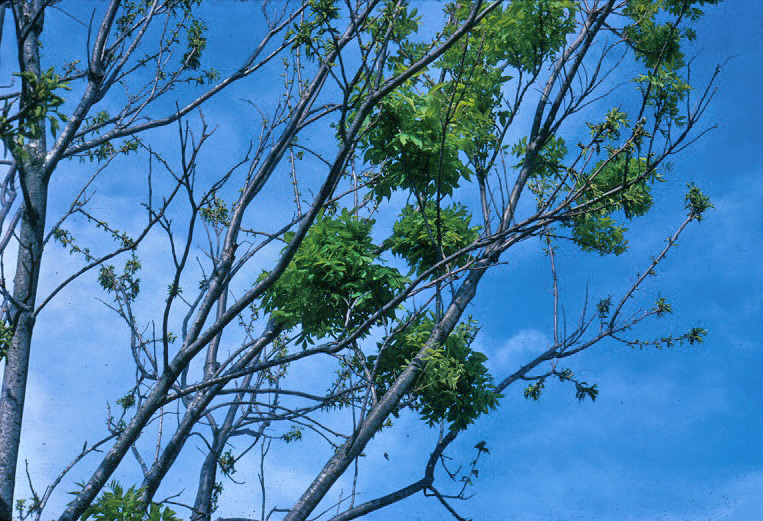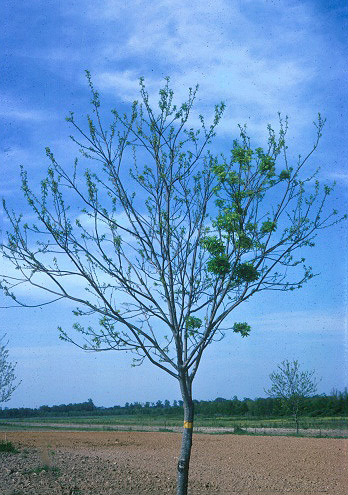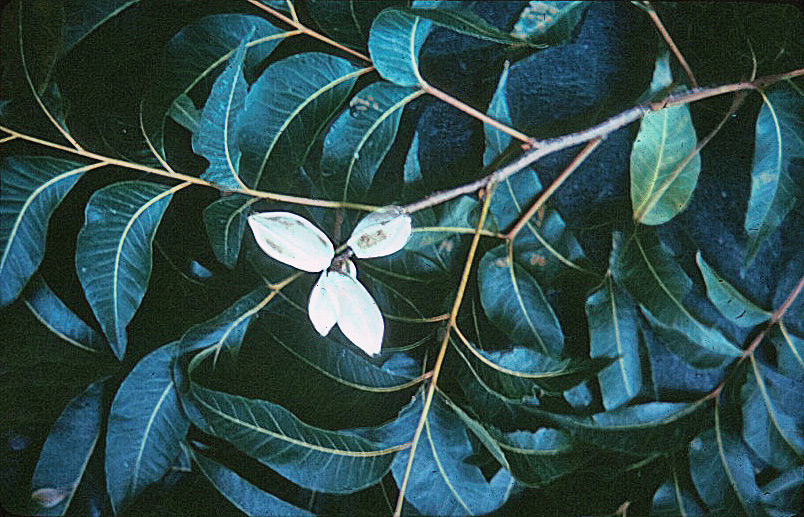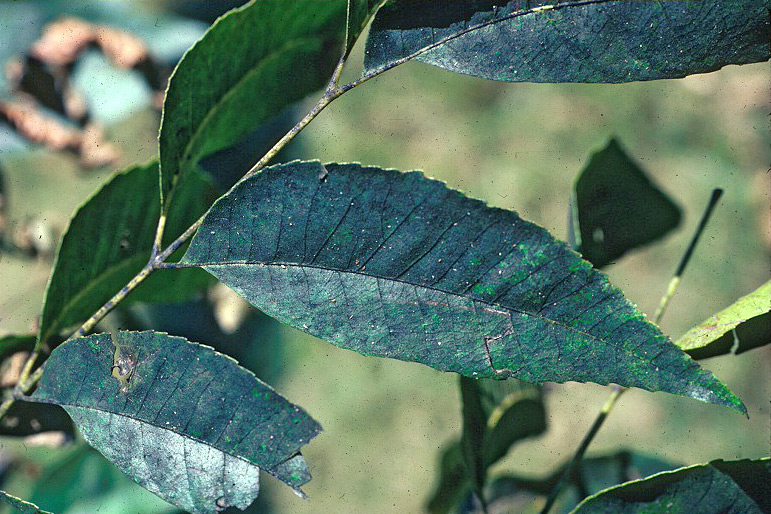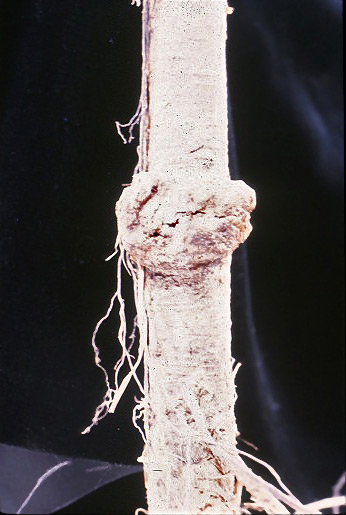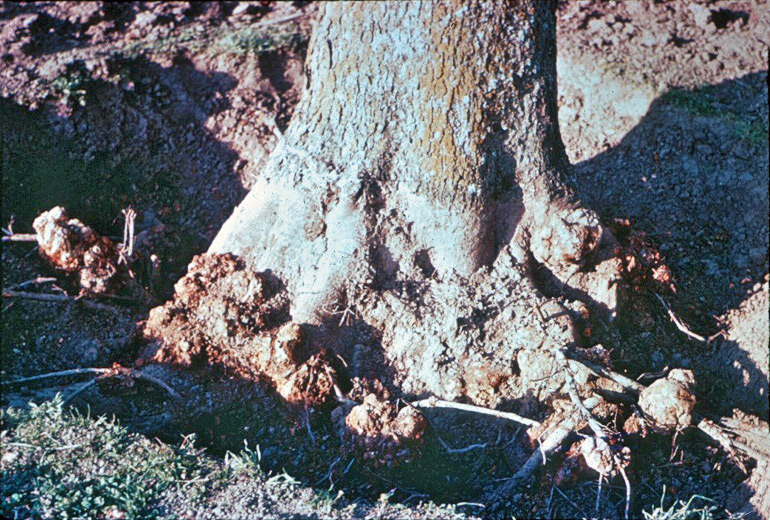Our Mississippi environment and soils are similar to other southeastern states. Humidity and soils in the southwest can be quite different from what we deal with here in Mississippi. Therefore, articles presented here are typically in that southeastern direction. We are not endorsing or recommending information presented here – just providing it for you. Hopefully, with the information we present here, you can gather the knowledge you need to make wise decisions. Thanks to Dr. Randy S. Sanderlin at the LSU AgCenter for the following article.
Mississippi State University Extension – Pecan Publications – website
Pecan Scab Disease
This disease, caused by the fungus Fusicladium effusum, is the most economically important disease of pecans. The pathogen can infect growing tissue of stems, leaves, and nuts. Infection causes black circular lesions that can be pinpoint size to one-quarter inch in diameter. Infection of stems can reduce growth and severe infection of stems can kill the current season’s terminal growth. Infection of leaves (Figure 1) can reduce the food production efficiency of trees. Severe infection of leaves early in the season may cause the leaves to drop from the trees. The leaves and stems are only susceptible to infection during the time that they are enlarging, usually becoming resistant to infection around mid-June.
Nuts are susceptible to infection from the time they are formed in the spring until they reach maturity in the fall (Figure 2). Increases in severity of the disease occur during rainfall periods. The amount of damage caused by scab disease depends on both the severity of infection and the stage of nut development when infection occurs. For a given level of severity, greater damage occurs when infection takes place in earlier nut growth stages. However, infection even late in the summer can cause an economic loss of yield. Figure 3 shows a range severity of infection from uninfected to total infection on nuts.
Pecan cultivars (varieties) vary in their susceptibility to the scab pathogen. Control of the disease is dependent on the use of fungicide applications to prevent infection. Control of pecan scab with fungicide is expensive because multiple applications of fungicides are required from the time trees begin to grow in the spring until the nuts mature in the fall. A list of fungicides recommended for pecan scab disease control is included at the end of this article. You may also contact your local Cooperative Extension office for additional specific recommendations to manage pecan scab disease.
Pecan Bacterial Leaf Scorch
Pecan bacterial leaf scorch is caused by the bacterium Xylella fastidiosa. Symptoms of the disease include browning of leaflets beginning at the tips and/or margins. The area of dead tissue increases towards the midrib and base of the leaflets (Figure 4). The affected leaflets drop from the leaf stem shortly after onset of symptoms. An entire tree can be affected or symptoms may be limited to one or more major limbs. Often the leaflets on one side of a compound leaf develop symptoms before the other side which can result in a leaf that has lost leaflets on one side only. Symptoms begin in mid-summer and tend to increase through fall. Severe leaf loss can accumulate from bacterial leaf scorch.
The bacterium can be transmitted through grafts when infected trees are used as a source of scion wood. Infection is apparently permanent and the disease is chronic, tending to occur at varying levels of severity each year. In other hosts, this bacterium is transmitted from plant to plant by leafhoppers, spittlebugs, and cicadas; however, insect vectors for pecan have not been identified. The bacterium does not kill pecan trees as it does some other hosts but severely affected trees can suffer yield loss almost every year. Once a tree is infected there is no control for the disease. Currently, over 20 cultivars (varieties) are recognized as susceptible to bacterial leaf scorch, but this number is likely to increase as more becomes known about this disease.
Vein Spot Disease
Vein spot disease on pecan is caused by the fungal pathogen Gnomonia nerviseda. The fungus survives the winter in leaf debris remaining from the previous year. In early spring, spores of the pathogen are produced in this leaf debris on the ground and can infect the current year’s foliage following rainfall in the spring and early summer. Defoliation of infected leaves occurs from late in the summer through fall. Infections that occur from April through June cause the most defoliation. Vein spot lesions are always located on leaf stems, leaflet stalks, leaflet midribs, or leaflet veins (Figure 5). These lesions are easily mistaken for scab lesions but can be distinguished because they have a smooth shiny surface as opposed to the sunken fuzzy appearance of scab lesions. The vein spot pathogen does not infect nuts but causes economic damage by reducing the food production capacity of trees through significant leaf loss. The disease can be controlled by preventative fungicide applications made prior to rainfall events in the spring.
Late Season Shock Disorders
Symptoms of this complex typically occur from mid-August through October. Shuck tissue begins to die and turns black starting at or near the tip of the shuck (shuck dieback) or near the base of the shuck (stem end blight, anthracnose). When shuck dying begins near the nut tip the blackening spreads over the shuck, which may stick tightly to the nut or flare open (Figure 6). Nuts with shuck dieback frequently remain attached to the tree. Although not well understood, this problem appears to be induced by or increased by stresses such as large crop load, low sunlight, pest problems, and tree crowding. No effective control measures have been found for shuck dieback and season long fungicide applications do not reduce its incidence or severity.
Another part of the late season shuck disorder complex does appear to be caused by a fungal pathogen. Anthracnose/stem end blight is associated with the fungal pathogen Glomerella cingulata (Colletotrichum gloeosporioides). This problem also occurs in late summer through fall and is often concurrent with shuck dieback. Generally, the symptoms of anthracnose begin near the point of attachment of the nut to the stem (Figure 7). The blackening of the shuck increases from the base of the nut toward the apical end of the nut. Usually, while the shuck is in the blackening process, nuts with anthracnose will drop from the tree or can be easily dislodged.
Shuck dieback is much more prevalent than anthracnose, occurring on some varieties almost every year while anthracnose develops more sporadically. Both problems have the same effect on nut development. When either problem begins in August or September, the nuts often develop as empty shells or as nuts with poorly filled kernels. In most years shuck dieback is the predominate problem. Measures that reduce tree stress such as irrigation, proper nutrition, tree thinning, and crop thinning may reduce the incidence of shuck dieback. Even though the incidence of anthracnose can be reduced with fungicides, recommendations are generally not made for control because the disease occurs sporadically and its occurrence cannot be predicted.
Downy Leaf Spot
Downy leaf spot is a foliar disease caused by the fungus Mycosphaerella caryigena. During the spring, the pathogen produces spores in leaf debris on the ground left from leaves that had downy spot the previous year. Leaves are infected in the spring, and whitish “frosty” lesions develop on the lower side of the leaflets (Figure 8). These spots become yellowish brown later in the summer (Figure 9). Infected leaflets will drop prematurely during the summer. In Louisiana, downy spot most often occurs on the cultivar Stuart, particularly in high humidity situations such as overcrowded orchards and orchards in river floodplains. In most years, downy spot is not an economic problem but it can occasionally warrant control effort. The disease can be controlled with the same preventative fungicide applications used for scab disease.
Bunch Disease
Pecan bunch disease is caused by a phytoplasm, which is a bacterial-like organism that lacks a typical bacterial cell wall. Trees with bunch disease have excessive lateral stems with shortened space between stems and compacted growth of leaves on these stems (Figure 10). Symptoms may be distributed throughout a tree or limited to individual limbs. Spread of the disease within a tree and within an orchard is usually erratic. Symptoms may be confined to one limb or a few trees for several years then begin to spread rapidly throughout the orchard. The disease is easiest to identify in the early spring because affected limbs will begin to develop shoot growth well before healthy limbs (Figure 11). It is not known how the pathogen spreads from pecan tree to pecan tree, but phytoplasms of other plants are transmitted by leafhoppers, making it likely that a similar vector is involved in pecan bunch disease. The pathogen can also be transmitted through grafts. Thus scion wood should not be collected from trees that have symptoms of bunch disease.
Terminals with bunch disease do not produce nuts. However, terminals without symptoms on the same tree can produce nuts, and the quality of the nuts is not affected by the disease. There are no control recommendations for this disease. Pruning limbs with symptoms and entire tree removal usually are not effective in preventing spread of the disease within trees or to other trees in an orchard. In Louisiana, bunch disease is common in ungrafted, unmanaged pecan trees in wooded areas. It often seems that the disease spreads from these trees into planted orchards near the wooded areas. Regular orchard maintenance including fertilizer and pesticide applications seems to slow the spread of the disease into orchards.
Powdery Mildew
Powdery mildew disease of pecan, caused by the fungus Microsphaera penicillata, occurs primarily on the surface of nut shucks. The disease first appears as a whitish powdery covering on shucks (Figure 12). In a few weeks, the whitish fungal growth fades away, and the infected shucks develop a brownish cast over the typical green tissue (Figure 13). The disease is most prevalent following periods of several days of high humidity with mild temperatures. There is not much data that supports an economic effect of this disease but severe infection can apparently reduce nut size. Some of the fungicides used for pecan scab control are more effective than others at reducing the severity of powdery mildew. However, because the disease is sporadic in occurrence and not considered a significant economic problem, specific fungicide application for powdery mildew is not usually recommended. If this disease is a consistent problem on your pecans, consult with your local county agent or the LSU AgCenter Pecan Station for the best fungicides to use.
Sooty Mold
Sooty mold occurs when various fungi grow on the sugary excrement of aphids that feed on pecan leaves. This substance is usually referred to as “honeydew” because it has a sticky consistency that covers surfaces it is deposited on. The fungi that form sooty mold do not grow into the leaves but live on the honeydew on the leaf surface. The sooty mold fungi produce a black coating on leaves (Figure 14) that can block sunlight from the leaf surface and reduce food production by trees. The economic effect of sooty mold is not known, but reduction in food storage levels in pecan trees is known to reduce kernel growth in the current year and nut production in the next year’s crop. Sooty mold growth can be reduced by limiting the development of aphids on the leaves.
Crown Gall Disease
The bacterium that causes crown gall disease, Agrobacterium tumefaciens, infects many plants causing gall formation on the roots of young plants and near the junction of the stem with the root system (Figure 15). On pecan, galls can vary in diameter from marble size to several inches across. Older galls (Figure 16) can often be easily broken off the base of trees which is one way they can be distinguished from knots caused by non-pathogen sources. Severe infection of young pecan plants could result in tree death, but most often the tree growth is stunted. As pecan trees with crown gall disease get larger they become more susceptible to wind throw than trees without galls.
The bacterium is common in heavy clay soils and infects pecan trees through wounds on the roots or crown area of trees. Once infection has occurred, there is no practical control. The bacterium can be spread from infected tree sites to other areas by transfer of soil on equipment. The root systems of trees purchased for transplanting should be examined carefully before planting to try to avoid planting infected trees. Practices such as discing are not recommended in pecan orchards because the roots can be wounded providing an avenue for infection if the bacterium is present in the soil. Likewise, care should be taken to avoid wounding the base of young trees with mowing equipment. If one area of an orchard has trees with crown gall, care should be taken to avoid transporting soil particles from the infested area into areas without the disease.

